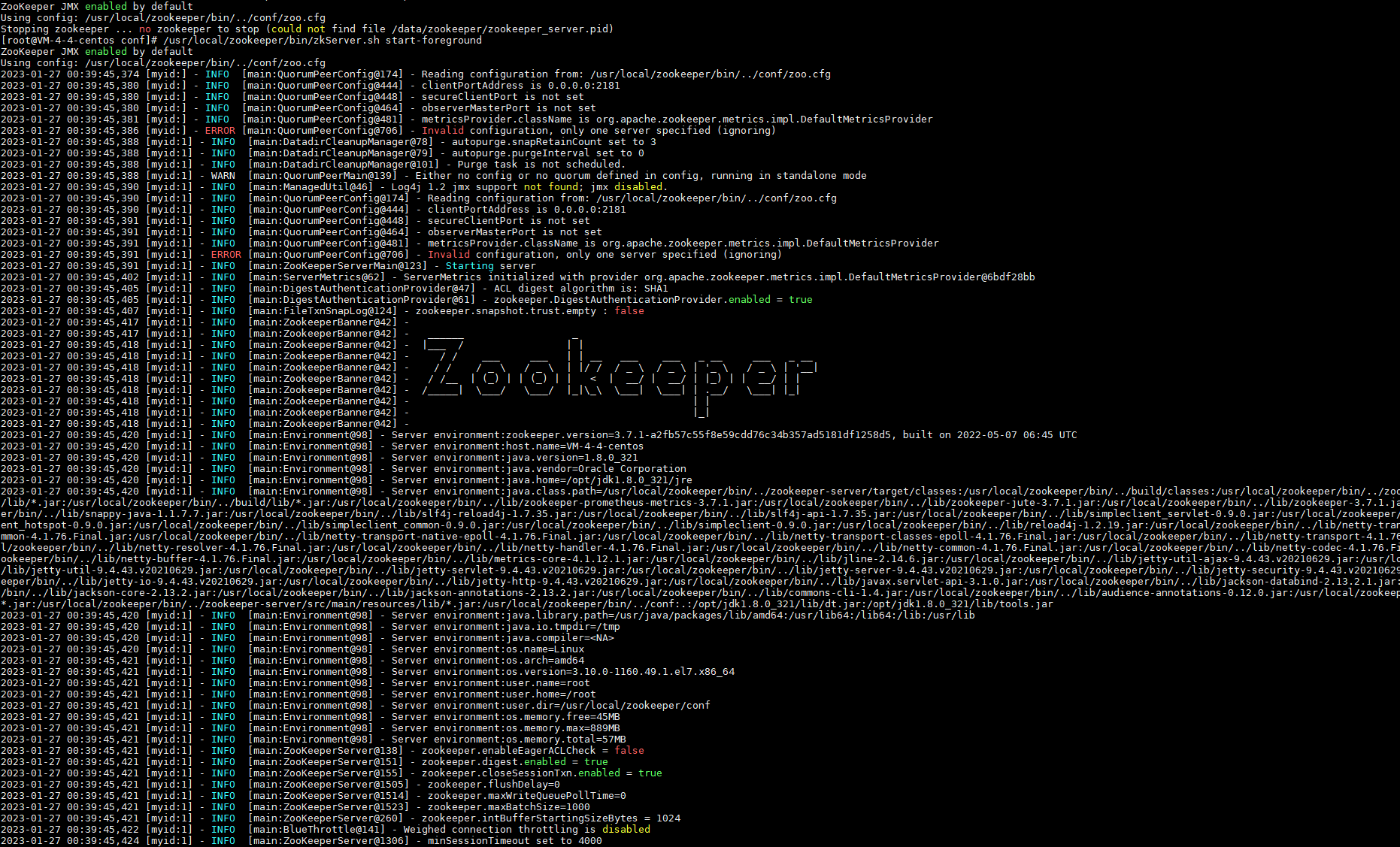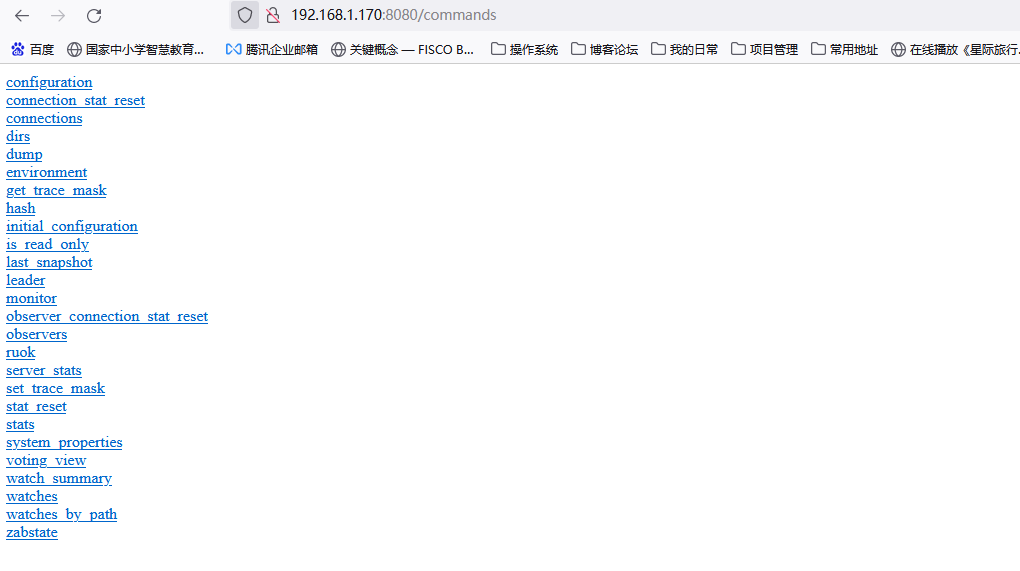Neo4j 安装说明(Linux)
一、集群主机
启动虚拟机,至少准备两个ip,也可准备三个。
| 序号 | IP | 角色 |
|---|---|---|
| 1 | 192.168.3.73 | Master、Slave |
二、下载安装
1、下载并安装 Neo4j
- 社区版:https://neo4j.com/download-center/#community
- 链接地址(Linux版):https://neo4j.com/artifact.php?name=neo4j-community-5.19.0-unix.tar.gz
- 链接地址(Windows):https://neo4j.com/artifact.php?name=neo4j-community-5.19.0-windows.zip
- 链接地址(Docker):https://hub.docker.com/_/neo4j/
所有的主机,下载安装最新稳定版 Neo4j (当前最新稳定版本为:5.19.0).
# 命令行下载比较慢,推荐直接浏览器下载(点击前面内容中的下载链接)
$ cd /usr/local/src && wget https://neo4j.com/artifact.php?name=neo4j-community-5.19.0-unix.tar.gz -O neo4j-community-5.19.0-unix.tar.gz --no-check-certificate
$ tar zxf neo4j-community-5.19.0-unix.tar.gz -C /usr/local/
$ echo 'export NEO4J_HOME="/usr/local/neo4j-community-5.19.0"' >>/etc/profile
$ echo 'export PATH="$NEO4J_HOME/bin:$PATH"' >>/etc/profile
$ source /etc/profile2、修改配置文件
首先查看下 /usr/local/neo4j-community-5.19.0/conf/ 目录下的 neo4j-admin.conf 文件,内容如下:
#********************************************************************
# Memory Settings
#********************************************************************
#
# Since the memory requirements of administration tasks generally differs from
# the ones of the DBMS, it is recommended to provide an administration-task-specific
# memory configuration.
#
# Memory settings are specified kibibytes with the 'k' suffix, mebibytes with
# 'm' and gibibytes with 'g'.
#
# Java Heap Size: If not explicitly set in neo4j.conf, the Java heap size is dynamically
# calculated based on available system resources. Uncomment these lines to set specific
# initial and maximum heap size.
#server.memory.heap.initial_size=512m
#server.memory.heap.max_size=512m
#
# The amount of memory to use for mapping the store files.
# If not explicitly set in any of the configuration files, the default page cache memory
# assumes the machine is dedicated to running Neo4j, and is heuristically set to 50% of RAM minus
# the Java heap size.
#server.memory.pagecache.size=10g
#********************************************************************
# JVM Parameters
#********************************************************************
# Parallel GC as throughput-oriented GC is ideal for administration tasks.
server.jvm.additional=-XX:+UseParallelGC
# Have common exceptions keep producing stack traces, so they can be
# debugged regardless of how often logs are rotated.
server.jvm.additional=-XX:-OmitStackTraceInFastThrow
# Trust that non-static final fields are really final.
# This allows more optimizations and improves overall performance.
server.jvm.additional=-XX:+UnlockExperimentalVMOptions
server.jvm.additional=-XX:+TrustFinalNonStaticFields
# Disable explicit garbage collection, which is occasionally invoked by the JDK itself.
server.jvm.additional=-XX:+DisableExplicitGC
# Restrict size of cached JDK buffers to 1 KB
server.jvm.additional=-Djdk.nio.maxCachedBufferSize=1024
# More efficient buffer allocation in Netty by allowing direct no cleaner buffers.
server.jvm.additional=-Dio.netty.tryReflectionSetAccessible=true
# Exits JVM on the first occurrence of an out-of-memory error. Its preferable to restart VM in case of out of memory errors.
server.jvm.additional=-XX:+ExitOnOutOfMemoryError
# Expand Diffie Hellman (DH) key size from default 1024 to 2048 for DH-RSA cipher suites used in server TLS handshakes.
# This is to protect the server from any potential passive eavesdropping.
server.jvm.additional=-Djdk.tls.ephemeralDHKeySize=2048
# Enable remote debugging
#server.jvm.additional=-agentlib:jdwp=transport=dt_socket,server=y,suspend=n,address=*:5005
# This filter prevents deserialization of arbitrary objects via java object serialization, addressing potential vulnerabilities.
# By default this filter whitelists all neo4j classes, as well as classes from the hazelcast library and the java standard library.
# These defaults should only be modified by expert users!
# For more details (including filter syntax) see: https://openjdk.java.net/jeps/290
#server.jvm.additional=-Djdk.serialFilter=java.**;org.neo4j.**;com.neo4j.**;com.hazelcast.**;net.sf.ehcache.Element;com.sun.proxy.*;org.openjdk.jmh.**;!*
# Increase the default flight recorder stack sampling depth from 64 to 256, to avoid truncating frames when profiling.
server.jvm.additional=-XX:FlightRecorderOptions=stackdepth=256
# Allow profilers to sample between safepoints. Without this, sampling profilers may produce less accurate results.
server.jvm.additional=-XX:+UnlockDiagnosticVMOptions
server.jvm.additional=-XX:+DebugNonSafepoints
# Open modules for neo4j to allow internal access
server.jvm.additional=--add-opens=java.base/java.nio=ALL-UNNAMED
server.jvm.additional=--add-opens=java.base/java.io=ALL-UNNAMED
server.jvm.additional=--add-opens=java.base/sun.nio.ch=ALL-UNNAMED
# Enable access to JDK vector API
# server.jvm.additional=--add-modules=jdk.incubator.vector
# Disable logging JMX endpoint.
server.jvm.additional=-Dlog4j2.disable.jmx=true#*****************************************************************
# Neo4j configuration
#
# For more details and a complete list of settings, please see
# https://neo4j.com/docs/operations-manual/current/reference/configuration-settings/
#*****************************************************************
# The name of the default database
#initial.dbms.default_database=neo4j
# Paths of directories in the installation.
#server.directories.data=data
#server.directories.plugins=plugins
#server.directories.logs=logs
#server.directories.lib=lib
#server.directories.run=run
#server.directories.licenses=licenses
#server.directories.transaction.logs.root=data/transactions
# This setting constrains all `LOAD CSV` import files to be under the `import` directory. Remove or comment it out to
# allow files to be loaded from anywhere in the filesystem; this introduces possible security problems. See the
# `LOAD CSV` section of the manual for details.
server.directories.import=import
# Whether requests to Neo4j are authenticated.
# To disable authentication, uncomment this line
#dbms.security.auth_enabled=false
#********************************************************************
# Memory Settings
#********************************************************************
#
# Memory settings are specified kibibytes with the 'k' suffix, mebibytes with
# 'm' and gibibytes with 'g'.
# If Neo4j is running on a dedicated server, then it is generally recommended
# to leave about 2-4 gigabytes for the operating system, give the JVM enough
# heap to hold all your transaction state and query context, and then leave the
# rest for the page cache.
# Java Heap Size: by default the Java heap size is dynamically calculated based
# on available system resources. Uncomment these lines to set specific initial
# and maximum heap size.
#server.memory.heap.initial_size=512m
#server.memory.heap.max_size=512m
# The amount of memory to use for mapping the store files.
# The default page cache memory assumes the machine is dedicated to running
# Neo4j, and is heuristically set to 50% of RAM minus the Java heap size.
#server.memory.pagecache.size=10g
# Limit the amount of memory that all of the running transaction can consume.
# The default value is 70% of the heap size limit.
#dbms.memory.transaction.total.max=256m
# Limit the amount of memory that a single transaction can consume.
# By default there is no limit.
#db.memory.transaction.max=16m
#*****************************************************************
# Network connector configuration
#*****************************************************************
# With default configuration Neo4j only accepts local connections.
# To accept non-local connections, uncomment this line:
#server.default_listen_address=0.0.0.0
# You can also choose a specific network interface, and configure a non-default
# port for each connector, by setting their individual listen_address.
# The address at which this server can be reached by its clients. This may be the server's IP address or DNS name, or
# it may be the address of a reverse proxy which sits in front of the server. This setting may be overridden for
# individual connectors below.
#server.default_advertised_address=localhost
# You can also choose a specific advertised hostname or IP address, and
# configure an advertised port for each connector, by setting their
# individual advertised_address.
# By default, encryption is turned off.
# To turn on encryption, an ssl policy for the connector needs to be configured
# Read more in SSL policy section in this file for how to define a SSL policy.
# Bolt connector
server.bolt.enabled=true
#server.bolt.tls_level=DISABLED
#server.bolt.listen_address=:7687
#server.bolt.advertised_address=:7687
# HTTP Connector. There can be zero or one HTTP connectors.
server.http.enabled=true
#server.http.listen_address=:7474
#server.http.advertised_address=:7474
# HTTPS Connector. There can be zero or one HTTPS connectors.
server.https.enabled=false
#server.https.listen_address=:7473
#server.https.advertised_address=:7473
# Number of Neo4j worker threads.
#server.threads.worker_count=
#*****************************************************************
# SSL policy configuration
#*****************************************************************
# Each policy is configured under a separate namespace, e.g.
# dbms.ssl.policy.<scope>.*
# <scope> can be any of 'bolt', 'https', 'cluster' or 'backup'
#
# The scope is the name of the component where the policy will be used
# Each component where the use of an ssl policy is desired needs to declare at least one setting of the policy.
# Allowable values are 'bolt', 'https', 'cluster' or 'backup'.
# E.g if bolt and https connectors should use the same policy, the following could be declared
# dbms.ssl.policy.bolt.base_directory=certificates/default
# dbms.ssl.policy.https.base_directory=certificates/default
# However, it's strongly encouraged to not use the same key pair for multiple scopes.
#
# N.B: Note that a connector must be configured to support/require
# SSL/TLS for the policy to actually be utilized.
#
# see: dbms.connector.*.tls_level
# SSL settings (dbms.ssl.policy.<scope>.*)
# .base_directory Base directory for SSL policies paths. All relative paths within the
# SSL configuration will be resolved from the base dir.
#
# .private_key A path to the key file relative to the '.base_directory'.
#
# .private_key_password The password for the private key.
#
# .public_certificate A path to the public certificate file relative to the '.base_directory'.
#
# .trusted_dir A path to a directory containing trusted certificates.
#
# .revoked_dir Path to the directory with Certificate Revocation Lists (CRLs).
#
# .verify_hostname If true, the server will verify the hostname that the client uses to connect with. In order
# for this to work, the server public certificate must have a valid CN and/or matching
# Subject Alternative Names.
#
# .client_auth How the client should be authorized. Possible values are: 'none', 'optional', 'require'.
#
# .tls_versions A comma-separated list of allowed TLS versions. By default only TLSv1.2 is allowed.
#
# .trust_all Setting this to 'true' will ignore the trust truststore, trusting all clients and servers.
# Use of this mode is discouraged. It would offer encryption but no security.
#
# .ciphers A comma-separated list of allowed ciphers. The default ciphers are the defaults of
# the JVM platform.
# Bolt SSL configuration
#dbms.ssl.policy.bolt.enabled=true
#dbms.ssl.policy.bolt.base_directory=certificates/bolt
#dbms.ssl.policy.bolt.private_key=private.key
#dbms.ssl.policy.bolt.public_certificate=public.crt
#dbms.ssl.policy.bolt.client_auth=NONE
# Https SSL configuration
#dbms.ssl.policy.https.enabled=true
#dbms.ssl.policy.https.base_directory=certificates/https
#dbms.ssl.policy.https.private_key=private.key
#dbms.ssl.policy.https.public_certificate=public.crt
#dbms.ssl.policy.https.client_auth=NONE
# Cluster SSL configuration
#dbms.ssl.policy.cluster.enabled=true
#dbms.ssl.policy.cluster.base_directory=certificates/cluster
#dbms.ssl.policy.cluster.private_key=private.key
#dbms.ssl.policy.cluster.public_certificate=public.crt
# Backup SSL configuration
#dbms.ssl.policy.backup.enabled=true
#dbms.ssl.policy.backup.base_directory=certificates/backup
#dbms.ssl.policy.backup.private_key=private.key
#dbms.ssl.policy.backup.public_certificate=public.crt
#*****************************************************************
# Logging configuration
#*****************************************************************
# To enable HTTP logging, uncomment this line
#dbms.logs.http.enabled=true
# To enable GC Logging, uncomment this line
#server.logs.gc.enabled=true
# GC Logging Options
# see https://docs.oracle.com/en/java/javase/11/tools/java.html#GUID-BE93ABDC-999C-4CB5-A88B-1994AAAC74D5
#server.logs.gc.options=-Xlog:gc*,safepoint,age*=trace
# Number of GC logs to keep.
#server.logs.gc.rotation.keep_number=5
# Size of each GC log that is kept.
#server.logs.gc.rotation.size=20m
#*****************************************************************
# Miscellaneous configuration
#*****************************************************************
# Determines if Cypher will allow using file URLs when loading data using
# `LOAD CSV`. Setting this value to `false` will cause Neo4j to fail `LOAD CSV`
# clauses that load data from the file system.
#dbms.security.allow_csv_import_from_file_urls=true
# Value of the Access-Control-Allow-Origin header sent over any HTTP or HTTPS
# connector. This defaults to '*', which allows broadest compatibility. Note
# that any URI provided here limits HTTP/HTTPS access to that URI only.
#dbms.security.http_access_control_allow_origin=*
# Value of the HTTP Strict-Transport-Security (HSTS) response header. This header
# tells browsers that a webpage should only be accessed using HTTPS instead of HTTP.
# It is attached to every HTTPS response. Setting is not set by default so
# 'Strict-Transport-Security' header is not sent. Value is expected to contain
# directives like 'max-age', 'includeSubDomains' and 'preload'.
#dbms.security.http_strict_transport_security=
# Retention policy for transaction logs needed to perform recovery and backups.
db.tx_log.rotation.retention_policy=2 days 2G
# Whether or not any database on this instance are read_only by default.
# If false, individual databases may be marked as read_only using dbms.database.read_only.
# If true, individual databases may be marked as writable using dbms.databases.writable.
#dbms.databases.default_to_read_only=false
# Comma separated list of JAX-RS packages containing JAX-RS resources, one
# package name for each mountpoint. The listed package names will be loaded
# under the mountpoints specified. Uncomment this line to mount the
# org.neo4j.examples.server.unmanaged.HelloWorldResource.java from
# neo4j-server-examples under /examples/unmanaged, resulting in a final URL of
# http://localhost:7474/examples/unmanaged/helloworld/{nodeId}
#server.unmanaged_extension_classes=org.neo4j.examples.server.unmanaged=/examples/unmanaged
# A comma separated list of procedures and user defined functions that are allowed
# full access to the database through unsupported/insecure internal APIs.
#dbms.security.procedures.unrestricted=my.extensions.example,my.procedures.*
# A comma separated list of procedures to be loaded by default.
# Leaving this unconfigured will load all procedures found.
#dbms.security.procedures.allowlist=apoc.coll.*,apoc.load.*,gds.*
#********************************************************************
# JVM Parameters
#********************************************************************
# G1GC generally strikes a good balance between throughput and tail
# latency, without too much tuning.
server.jvm.additional=-XX:+UseG1GC
# Have common exceptions keep producing stack traces, so they can be
# debugged regardless of how often logs are rotated.
server.jvm.additional=-XX:-OmitStackTraceInFastThrow
# Make sure that `initmemory` is not only allocated, but committed to
# the process, before starting the database. This reduces memory
# fragmentation, increasing the effectiveness of transparent huge
# pages. It also reduces the possibility of seeing performance drop
# due to heap-growing GC events, where a decrease in available page
# cache leads to an increase in mean IO response time.
# Try reducing the heap memory, if this flag degrades performance.
server.jvm.additional=-XX:+AlwaysPreTouch
# Trust that non-static final fields are really final.
# This allows more optimizations and improves overall performance.
# NOTE: Disable this if you use embedded mode, or have extensions or dependencies that may use reflection or
# serialization to change the value of final fields!
server.jvm.additional=-XX:+UnlockExperimentalVMOptions
server.jvm.additional=-XX:+TrustFinalNonStaticFields
# Disable explicit garbage collection, which is occasionally invoked by the JDK itself.
server.jvm.additional=-XX:+DisableExplicitGC
# Restrict size of cached JDK buffers to 1 KB
server.jvm.additional=-Djdk.nio.maxCachedBufferSize=1024
# More efficient buffer allocation in Netty by allowing direct no cleaner buffers.
server.jvm.additional=-Dio.netty.tryReflectionSetAccessible=true
# Exits JVM on the first occurrence of an out-of-memory error. Its preferable to restart VM in case of out of memory errors.
# server.jvm.additional=-XX:+ExitOnOutOfMemoryError
# Expand Diffie Hellman (DH) key size from default 1024 to 2048 for DH-RSA cipher suites used in server TLS handshakes.
# This is to protect the server from any potential passive eavesdropping.
server.jvm.additional=-Djdk.tls.ephemeralDHKeySize=2048
# This mitigates a DDoS vector.
server.jvm.additional=-Djdk.tls.rejectClientInitiatedRenegotiation=true
# Enable remote debugging
#server.jvm.additional=-agentlib:jdwp=transport=dt_socket,server=y,suspend=n,address=*:5005
# This filter prevents deserialization of arbitrary objects via java object serialization, addressing potential vulnerabilities.
# By default this filter whitelists all neo4j classes, as well as classes from the hazelcast library and the java standard library.
# These defaults should only be modified by expert users!
# For more details (including filter syntax) see: https://openjdk.java.net/jeps/290
#server.jvm.additional=-Djdk.serialFilter=java.**;org.neo4j.**;com.neo4j.**;com.hazelcast.**;net.sf.ehcache.Element;com.sun.proxy.*;org.openjdk.jmh.**;!*
# Increase the default flight recorder stack sampling depth from 64 to 256, to avoid truncating frames when profiling.
server.jvm.additional=-XX:FlightRecorderOptions=stackdepth=256
# Allow profilers to sample between safepoints. Without this, sampling profilers may produce less accurate results.
server.jvm.additional=-XX:+UnlockDiagnosticVMOptions
server.jvm.additional=-XX:+DebugNonSafepoints
# Open modules for neo4j to allow internal access
server.jvm.additional=--add-opens=java.base/java.nio=ALL-UNNAMED
server.jvm.additional=--add-opens=java.base/java.io=ALL-UNNAMED
server.jvm.additional=--add-opens=java.base/sun.nio.ch=ALL-UNNAMED
# Enable access to JDK vector API
# server.jvm.additional=--add-modules=jdk.incubator.vector
# Disable logging JMX endpoint.
server.jvm.additional=-Dlog4j2.disable.jmx=true
# Limit JVM metaspace and code cache to allow garbage collection. Used by cypher for code generation and may grow indefinitely unless constrained.
# Useful for memory constrained environments
#server.jvm.additional=-XX:MaxMetaspaceSize=1024m
#server.jvm.additional=-XX:ReservedCodeCacheSize=512m
# Allow big methods to be JIT compiled.
# Useful for big queries and big expressions where cypher code generation can create large methods.
#server.jvm.additional=-XX:-DontCompileHugeMethods
#********************************************************************
# Wrapper Windows NT/2000/XP Service Properties
#********************************************************************
# WARNING - Do not modify any of these properties when an application
# using this configuration file has been installed as a service.
# Please uninstall the service before modifying this section. The
# service can then be reinstalled.
# Name of the service
server.windows_service_name=neo4j
#********************************************************************
# Other Neo4j system properties
#********************************************************************注意:在每台主机上都执行以下命令 !
$ cd zookeeper/conf && cp -p zoo_sample.cfg zoo.cfg
$ mkdir -p /home/zookeeper/data
$ mkdir -p /home/zookeeper/logs
## 取消54行注释
dbms.connectors.default_listen_address=0.0.0.0
在 server.1 上执行:
$ echo 1 > /home/zookeeper/data/myid配置完成后,切记一定要放开云服务器安全策略的 2181,2888,3888 几个端口,主机还需要关闭防火墙(一开始没关闭没成功);执行以下命令,实时看到启动的情况:

./bin/neo4j console # 以控制台应用运行
./bin/neo4j start # 以后台进程运行可用命令:
zkServer.sh start 启动zk服务
zkServer.sh stop 停止zk服务
zkServer.sh restart 重启zk服务
zkServer.sh status 查看zk服务状态
启动后浏览器也可以访问查看状态:http://ip:8080/commands; 我这里是 :http://192.168.1.170:8080/commands

3、开机启动
[root@nacos nacos]# vi /lib/systemd/system/zookeeper.service脚本内容:
[Unit]
Description=Zookeeper 3.x
After=network.target
[Service]
User=zookeeper
Type=forking
Environment=ZOO_LOG_DIR='/home/zookeeper/logs'
Environment=JAVA_HOME='/usr/local/java'
ExecStart=/usr/local/zookeeper/bin/zkServer.sh start
ExecStop=/usr/local/zookeeper/bin/zkServer.sh stop
ExecReload=/usr/local/zookeeper/bin/zkServer.sh restart
Restart=on-failure
StartLimitInterval=60
StartLimitBurst=3000
[Install]
WantedBy=multi-user.target创建 zookeeper:zookeeper 用户组和用户,并进行授权:
$ groupadd zookeeper
$ useradd -g zookeeper -M -s /sbin/nologin zookeeper
$ chown -R zookeeper. /home/zookeeper/data
$ chown -R zookeeper. /home/zookeeper/logs设置随机启动:
[root@nacos nacos]# systemctl daemon-reload
[root@nacos nacos]# systemctl enable zookeeper.service
[root@nacos nacos]# systemctl start zookeeper.service
[root@nacos nacos]# systemctl status zookeeper.service查询主节点状态:
$ /usr/local/zookeeper/bin/zkServer.sh status浏览器
http://localhost:7474/
初始用户名和密码:neo4j
修改密码:neo4j.
作者:Jeebiz 创建时间:2023-12-11 12:07
最后编辑:Jeebiz 更新时间:2025-11-18 10:09
最后编辑:Jeebiz 更新时间:2025-11-18 10:09
